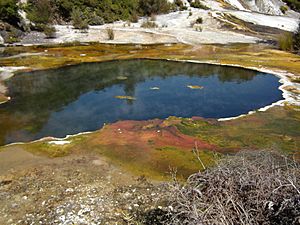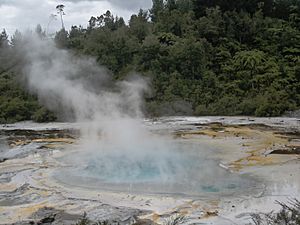Orakei Korako facts for kids
Orakei Korako is an amazing geothermal area in New Zealand. It's famous for its beautiful terraces made of a mineral called sinter. You can find it in a hidden valley near the Waikato River, north of Taupo. People often call it "The Hidden Valley." The name Ōrakei Kōrako means "place of adornment near the white [sinter flat]" in the Māori language.
Contents
A Look Back: History of Orakei Korako
Early Māori Life in the Valley
For a very long time, the Māori lived in the Waikato Valley near Orakei Korako. They were part of the Ngāti Tahu tribe. By the early 1800s, many Māori gathered here. They loved the hot springs because they could use them for cooking and bathing. We don't know exactly when they left the valley. Some think they moved after the Mount Tarawera eruption in 1886. By the early 1900s, only two families still lived in Orakei Korako.
Welcoming Early Visitors
The first European travelers from Rotorua to Taupo passed right through Orakei Korako. The local Māori helped them cross the river using dugout canoes. In the early 1900s, Orakei Korako became a place for visitors. People used dugout canoes to cross the fast-flowing Waikato River. Later, in the 1930s, a special wire and pulley system was built. A punt (a flat-bottomed boat) was used to carry visitors across. The official tourist spot opened on December 15, 1937.
Building the Dam and Lake Ohakuri
Plans to use the river's power at Orakei Korako started in 1904. But it wasn't until 1955 that the project was approved. By May 1960, a huge earth dam was built. It was 49 meters (about 160 feet) tall above the river. On January 19, 1961, Lake Ohakuri began to fill up. It took only 14 days to complete the lake.
Lost Geysers of the Past
When the lake filled, it covered two of the world's biggest geysers. One was Minginui Geyser. It was once seen erupting up to 90 meters (about 295 feet) high! This is as tall as the world's highest active geyser today. The other was the Orakeikorako Geyser. It could erupt up to 55 meters (about 180 feet) high. This geyser actually gave the whole area its name.
Orakei Korako Today: A Hidden Valley of Wonders
The Emerald Terrace
The lowest terrace at Orakei Korako is the beautiful Emerald Terrace. It's a jade-green color. It's the biggest of its kind in New Zealand. This is because the famous Pink and White Terraces were destroyed in the 1886 Mount Tarawera eruption. When it rains a lot, up to 20 million liters (about 5.3 million gallons) of water flow over this terrace every day. This water is rich in silica and flows into Lake Ohakuri.
The Emerald Terrace continues for 35 meters (about 115 feet) under the lake. The lake was created in 1961 to make hydropower. This raised the Waikato River level by 18 meters (about 59 feet) at Orakei Korako. It flooded about 200 hot springs and 70 geysers. This was two-thirds of the active hot area! Some of these hot spots still release water. You can see gas bubbles rising from the lake bed.
New Zealand's Largest Geyser Field
Even with many hot spots now underwater, Orakei Korako is still the largest geyser field in New Zealand. It has up to 35 active geysers. The most famous one is the Diamond Geyser. Its eruptions are hard to predict. They can last from a few minutes to many hours. It shoots boiling water as high as nine meters (about 30 feet)!
The Colorful Terraces
Above the Emerald Terrace are three more large terraces. They are called fault scarps. They were formed by an earthquake in 131 AD. This was around the time Lake Taupo (a supervolcano) last erupted. These terraces are mostly covered in hot water algae, also called cyanobacteria. This algae grows in warm temperatures, between 35–59 degrees Celsius (95-138.2 degrees Fahrenheit). The colors depend on the type of algae. Green, yellow, and black are the most common.
Rainbow and Cascade Terraces
At the bottom of the two lower terraces, called Rainbow and Cascade Terraces, are several small geysers. One is the Sapphire Geyser, which erupts sometimes. There's also the Hochstetter Pool. It's named after Ferdinand von Hochstetter, a geologist who visited in 1859. This pool erupted in November 1954 and acted like a geyser until mid-1955. It stopped suddenly after many small earthquakes.
The Golden Fleece Terrace
The third and largest fault scarp is the Golden Fleece Terrace. The Māori people called it Te Kapua, meaning "The Cloud." It is five meters (about 16 feet) high and 40 meters (about 131 feet) long. It has a beautiful white, crystal-like sinter coating. At its base are many vents where geysers have appeared and disappeared over the years. The most recent one is the Wairiri Geyser.
The Artist's Palette
On top of the Golden Fleece Terrace is the Artist's Palette. This is a huge 10,000 square meter (about 107,639 square feet) sinter terrace. It's covered with clear blue pools of hot water. Geysers here erupt at different times. In 2001, a new geyser started erupting on one side of this terrace. It might be the start of another new terrace!
The Ruatapu Cave
Orakei Korako is also home to the Ruatapu Cave. This is one of only two caves in the world found in a geothermal area. The cave goes down 45 meters (about 148 feet). There's a vertical drop of 23 meters (about 75 feet) to a shallow pool of clear, warm, acid water. This water has a special chemical mix that can actually clean jewelry!
Other Amazing Features
Another cool spot at Orakei Korako is the Soda Fountain. It suddenly came back to life in 1984 after being quiet for 17 years.
There are three more geysers high up on a cliff above Lake Ohakuri. They are called Kurapai, Ellan Vannin, and Benedix Washer Geysers. This area is too dangerous for visitors. Temperatures of 100 degrees Celsius (212 degrees Fahrenheit) have been found very close to the ground here. The Kurapai Geyser is the most important of these. You can sometimes see it erupting from the visitor's center across the lake.
The Orakei Korako geothermal system is now protected. This means it's safe from too much new building.
Images for kids





